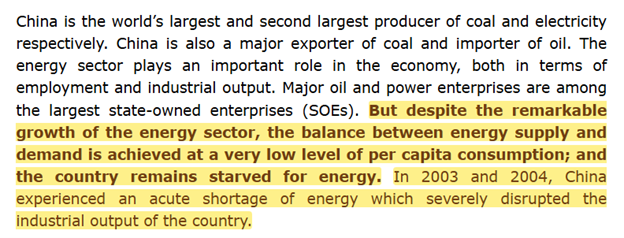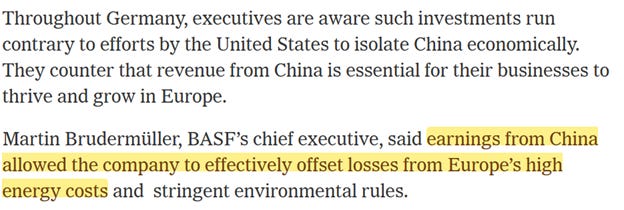Why is electricity so cheap in China?
"Bullet Trains for power" bring far-away energy to population centers
Good morning. Consider these charts:


China’s per-capita energy consumption is now about the same as the European Union. The typical Chinese uses as much energy as the typical Western European.
The chart on the left shows the cost of electricity around the world. The darker the color, the more expensive electricity costs. People living in Western Europe, Australia, and Japan see the highest electric bills. China’s electricity costs around 15 cents per kilowatt hour, which is about half what American consumers pay, and Chinese households pay even less than Canada.
These two charts shouldn’t be possible. And the reason is that China’s energy profile is quite poor, especially compared to North America. This is an old report from 20 years ago, June 2005. But it is typical of the analysis of China’s energy outlook, until very recently. The conclusions drawn by energy experts were uniform, and that China has a low ceiling for industrial and economic development, because of energy constraints here.
China’s is heavily reliant on coal, and is the world’s largest producer. They are also major importers of oil—they don’t have nearly as much as they need, and as of 2005 they were the second largest producer of electricity. There was a persistent supply-demand gap, and China’s heavy reliance on foreign suppliers makes China uniquely vulnerable to currency fluctuations, business cycles, and politics.
The balance between China’s energy supply and demand was only possible because China’s per capita consumption is low. The country is starved for energy, and in the years leading up to this report, China experienced blackouts which negatively impacted industrial production. The researchers concluded here that the only reason that China was able to produce most of the electricity that it needed, was because Chinese people don’t use very much.
That was in 2005, and we could have shared any one of a dozen other studies that all said the same thing: China has severe disadvantages in energy which would keep a lid on industrial production and economic growth. And it was unthinkable that China could be at the same level as in other developed countries, with respect to per-capita energy usage, especially at lower prices compared to Norway, or to Canada, but here we are.
German industrial giants moving to China, cite low power costs
And in fact, China’s low prices on energy, especially compared to Europe, are resulting in tough choices being made by German companies. More than half of Germany’s biggest companies are considering moving production out of Germany, especially the firms in energy-intensive industries. That’s causing headaches in Washington, where administration officials are pushing German companies to divest from China and Russia, but those companies are going the other way. BASF is one of the biggest chemical companies in the world, and they already have 30 plants here, and BASF is building a new facility in China that will be as big as their headquarters in Germany. Their CEO says that the company’s China divisions are making money, while in Europe they’re losing money:
“Name me one investment in Europe where we can make money”, he says. Volkswagen has the same problem. In Europe the energy costs are too high, labor costs too high, and VW needs sales in China to subsidize their European operations.
Adding solar, wind, and hydro to the energy mix
China needed to tackle several problems at the same time. They did develop deep diplomatic and economic ties with energy-producing countries, with Russia, Saudi Arabia and the UAE, and Venezuela most notably.
The Chinese also built out their energy portfolio to include massive volumes of renewable power, which is domestically produced and raised the ceiling, again, on the energy available to them, while reducing the cost. Those were crucial and go a long way to explain how they were able to dramatically increase energy production and usage, while also cutting costs. “It’s been remarkable”, this from PV magazine, which shows here how important solar power has been in China’s energy mix. China’s massive increase in solar capacity keeps power prices low compared to Europe and the United States. China’s end users pay less than half what Europeans or Australians do, and that is a key advantage in global trade. China has more consumers of electricity than Europe and the US combined, and “it would be a historic achievement if the prices stay low” as more renewables come on stream.
These tables show China is now the world’s number one producer and consumer of hydro power, solar, and wind.
The Missing Piece: UHV
These data, however, don’t come close to answering the question, because many of the problems that analysts pointed to in 2005 are still here. And we got a great heads-up on this part of the story from a subscriber in Ireland, who is an expert in the renewable energy markets. He forwarded a bunch of links and told us to look at the power transmission problem. China has revolutionized the transmission of electricity over vast distances, and that’s all happened since 2005.
UHV are ultra-high voltage lines for transmitting power. The principle here is that as higher voltages of power are sent down the lines, the marginal cost of doing so goes down. This also means less waste due to heat loss, and greater efficiency. Shikansen is the Chinese name for the systems, taken in turn from the Japanese name for their bullet trains, which become more efficient as their speeds go up.
The fastest way to supply electric power is not to produce it in nearby power plants, but rather by wire. Here is the problem that China had in 2005, and still has today: China’s natural resources are in the North and West, while China’s population centers are in the East and the South. And 20 years ago, China was suffering from chronic power outages. A huge chunk of the country’s logistics was devoted to just moving raw materials around to generate electricity, and they couldn’t keep up:
In 2006 it became a national-level strategy to develop China’s UHV transmission. Their first project went from Shanxi, the biggest coal-producing region, to Hubei. In the past the idea would be to haul coal from Shanxi province to Hubei, where it would be burned to generate electricity. With UHV the Chinese power grid operators could burn the coal in Shanxi and just send the electricity to Hubei. Lots of other projects came online, and the biggest one delivered hydroelectric power from the Jinsha River, across 8 provinces to Shanghai, and that UHV line provides sufficient power for 40% of Shanghai’s electricity demand.
Now China’s got 38 of these UHV lines online, and they now include wind and solar sources of power. UHV was not invented here, but China pushed it to the next level and developed many new technologies and applications.
China is now sharing this technology with friendly countries, including Brazil and India. These countries share similar energy profiles and geography: both are heavily dependent on foreign energy sources, and have massive population centers in coastal areas, far from where domestic power sources are generated.
Be good.
Resources and Links:
BBC: 'A bullet train for power': China's ultra-high-voltage electricity grid https://www.bbc.com/future/article/20241113-will-chinas-ultra-high-voltage-grid-pay-off-for-renewable-power
Energy in China: Development and Prospects https://journals.openedition.org/chinaperspectives/2783
Belo Monte Transmission Line Project: 'Electricity Expressway' in Brazil http://en.sasac.gov.cn/2023/10/13/c_16027.htm
Raigarh-Pugalur High Voltage Direct Current (HVDC) Pole I put into commercial operation https://pib.gov.in/PressReleasePage.aspx?PRID=1652561
A rising China is reshaping global energy markets
https://www.gisreportsonline.com/r/china-energy-markets/
China now uses about the same amount of energy per person as the European Union https://ourworldindata.org/data-insights/china-now-uses-about-the-same-amount-of-energy-per-person-as-the-european-union
Renewables helping China to halve power prices compared to US, Europe https://www.pv-magazine.com/2023/11/28/renewables-helping-china-to-halve-power-prices-compared-to-us-europe/
Cost of Electricity by Country 2024
https://worldpopulationreview.com/country-rankings/cost-of-electricity-by-country
New York Times, As U.S. Tries to Isolate China, German Companies Move Closer https://www.nytimes.com/2023/04/12/world/europe/germany-china-trade.html
High Energy Costs Prompt German Firms to Consider Relocating
Bloomberg, Four in Ten German Manufacturers Eye Move Abroad on Energy Costs https://www.bloomberg.com/news/articles/2024-08-01/four-in-ten-german-manufacturers-eye-move-abroad-on-energy-costs








so glad you are on substack so worth reading you!